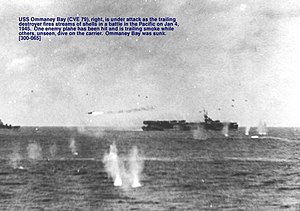USS Ommaney Bay
 USS Ommaney Bay under attack by kamikaze aircraft on 4 January 1945
| |
| History | |
|---|---|
| Name | USS Ommaney Bay |
| Namesake | Ommaney Bay, Alaska |
| Builder | Kaiser Shipyards |
| Laid down | 6 October 1943 |
| Launched | 29 December 1943 |
| Commissioned | 11 February 1944 |
| Fate | Struck by kamikaze aircraft, and scuttled 4 January 1945 |
| General characteristics | |
| Class and type | Casablanca-class escort carrier |
| Displacement |
|
| Length | 512 ft 3 in (156.13 m) overall |
| Beam |
|
| Draft | 22 ft 6 in (6.86 m) |
| Propulsion |
|
| Speed | 19.3 knots (35.7 km/h) |
| Range | 10,240 nmi (18,960 km) at 15 kn (28 km/h) |
| Complement |
|
| Armament |
|
| Aircraft carried | 28 |
| Service record | |
| Part of: | United States Pacific Fleet |
| Operations: | |
| Awards: | 2 Battle stars |
USS Ommaney Bay (CVE–79) was a Casablanca-class escort carrier of the United States Navy, named for Ommaney Bay, Alaska.
Ommaney Bay, formerly MC hull 1116, was laid down under a Maritime Commission contract 6 October 1943 by Kaiser Company, Inc., Vancouver, Washington; launched 29 December 1943, sponsored by Mrs. P. K. Robottom; acquired by the Navy 11 February 1944; and commissioned the same day, Captain Howard L. Young in command.
Service history
After commissioning and fitting out at Astoria, Oregon, and conducting shakedown in Puget Sound, Ommaney Bay sailed 19 March from Oakland, California, with passengers and a cargo of supplies and aircraft for Brisbane, Australia. (While the ship is presumably named for Ommaney Bay in Alaska, note that Brisbane has a landmark and suburb called Mount Ommaney.) By 27 April she had completed her mission and was back in San Diego, where she began a rigorous ten days of carrier qualification landings, drills and tests. Then, after minor alterations and repairs, the ship sailed 10 June for Pearl Harbor. Until 12 August she trained air groups and squadrons there in the art of operating from "baby flattops", then she sailed to Tulagi to rehearse for the invasion of the Palau Islands. From 11 September until the beginning of October Ommaney Bay stood off Peleliu and Anguar Islands and provided air cover for the fleet and close support strikes for the forces ashore.
Ommaney Bay sailed to Manus Island to renew her depleted stock of fuel and ammunition, then joined Rear Admiral Felix Stump's "Taffy 2" (TU 77.4.2) for the invasion of Leyte. At the beginning of the Battle off Samar on 25 October, the escort carriers began launching air strikes in an effort to cripple as many of the approaching enemy force as possible. In the ensuing battle aircraft from Ommaney Bay contributed to the sinking of one Japanese cruiser and helped to damage a number of other warships. Ommaney Bay launched some six strikes that day, and helped to turn threatened defeat into victory.
The carrier spent the month of November at Manus and Kossol Passage for availability and replenishment, then, from 12 December to 17 December, operated in the Mindanao and Sulu Seas in support of operations on the Island of Mindoro. On the 15th, a day of heavy enemy air attacks, she splashed an enemy bomber as it dived for the ship from the port bow. On 19 December she returned to Kossol Passage to prepare for the landings in Lingayen Gulf.
Sinking
Ommaney Bay left on New Year's Day 1945 and transited Surigao Strait two days later. The next afternoon, while in the Sulu Sea, a twin-engine Japanese suicide plane penetrated the screen undetected and made for Ommaney Bay. The plane nicked her island then crashed into her starboard side. Two bombs were released; one of them penetrated the flight deck and detonated below, setting off a series of explosions among the fully gassed planes on the forward third of the hangar deck. The second bomb passed through the hangar deck, ruptured the fire main on the second deck, and exploded near the starboard side.
Water pressure forward was lost immediately, along with power and bridge communications. Men struggling with the terrific blazes on the hangar deck soon had to abandon it because of the heavy black smoke from the burning planes and exploding .50 caliber ammunition. Escorts could not lend their power to the fight because of the exploding ammunition and intense heat from the fires. By 17:50 the entire topside area had become untenable, and the stored torpedo warheads threatened to go off at any time. The order to abandon ship was given.
At 19:45 the carrier was sunk by a torpedo from the destroyer Burns. A total of 95 Navy men were lost, including two killed on an assisting destroyer when torpedo warheads on the carrier's hangar deck finally went off.
See also
References
![]() This article incorporates text from the public domain Dictionary of American Naval Fighting Ships.
This article incorporates text from the public domain Dictionary of American Naval Fighting Ships.
External links
- Casablanca-class escort carriers
- World War II escort aircraft carriers of the United States
- Ships built in Washington (state)
- Shipwrecks in the Sulu Sea
- World War II shipwrecks in the Pacific Ocean
- 1943 ships
- Ships sunk by kamikaze attack
- Aircraft carriers sunk by aircraft
- Maritime incidents in January 1945
